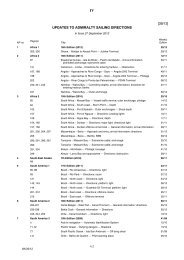Admiralty Lists of Radio Signals - The Tyneside Nautical Charts ...
Admiralty Lists of Radio Signals - The Tyneside Nautical Charts ...
Admiralty Lists of Radio Signals - The Tyneside Nautical Charts ...
You also want an ePaper? Increase the reach of your titles
YUMPU automatically turns print PDFs into web optimized ePapers that Google loves.
VI<br />
FINAL REPORTS:<br />
(1) An AUSREP Final Report (FR) should be sent:<br />
(a) For ships en route overseas and departing the AUSREP area, at the AUSREP<br />
boundary.<br />
(b) For ships ending a voyage at an Australian port within the REEFREP area, at<br />
the last REEFVTS reporting point.<br />
(c) For ships ending a voyage at any other Australian port, when within 2h steaming<br />
<strong>of</strong> the port or Pilot Station.<br />
(2) When a ship approaches an Australian destination and arrives at a position where<br />
VHF contact is made with the local Harbour Authority or Pilot Station, which under<br />
normal circumstances is within 2h steaming <strong>of</strong> the pilotage, an FR is to be sent to RCC<br />
Australia.<br />
(3) Mandatory fi elds for an FR are A and K.<br />
(4) Masters must ensure that an FR is always sent to RCC Australia to prevent<br />
unnecessary SAR action and a waste <strong>of</strong> valuable resources.<br />
(5) Example Final Report:<br />
ID System identifier and message type AUSREP/FR//<br />
A/HESPERUS/<br />
A Ship name/call sign/IMO No<br />
BCBC/8502458//<br />
Date, time and point <strong>of</strong> exit from AUSREP<br />
K<br />
K/080200UTC/ADELAIDE//<br />
area or Australian port <strong>of</strong> arrival<br />
APPENDIX A - SPECIAL REPORT TYPES DETAILED REPORTING<br />
REQUIREMENTS:<br />
(1) Dangerous Goods (DG) Reports: When an incident takes place involving the<br />
loss or likely loss overboard <strong>of</strong> packaged dangerous goods, including those in freight<br />
containers, portable tanks, road and rail vehicles and shipborne barges into the sea.<br />
<strong>The</strong> primary report should contain message format fi elds A, B, C, M, Q, R, S, T, U <strong>of</strong><br />
the standard reporting format. If the condition <strong>of</strong> the ship is such that there is danger <strong>of</strong><br />
further loss <strong>of</strong> packaged dangerous goods into the sea, fi elds P and Q <strong>of</strong> the standard<br />
reporting format should be reported.<br />
Example <strong>of</strong> Dangerous Goods (DG) Report:<br />
Dangerous Goods (DG) Report<br />
ID System identifier and message type<br />
A Ship name/call sign/IMO No<br />
B Date/time <strong>of</strong> position<br />
C Position<br />
M Coast <strong>Radio</strong> Stations monitored/Inmarsat numbers<br />
P<br />
Q<br />
P1 Correct technical name or names <strong>of</strong> goods<br />
P2 UN number or numbers<br />
P3 IMO hazard class or classes<br />
P4 Names <strong>of</strong> manufacturers <strong>of</strong> goods when known, or consignee or<br />
consignor<br />
P5 Types <strong>of</strong> packages including identifi cation marks. Specify whether<br />
portable tank or tank vehicle, or whether vehicle or freight container or other<br />
cargo transport unit containing packages. Include <strong>of</strong>fi cial registration marks<br />
and numbers assigned to the unit<br />
P6 An estimate <strong>of</strong> the quantity and likely condition <strong>of</strong> the goods<br />
Q1 An assessment <strong>of</strong> the defects and damage<br />
Q2 <strong>The</strong> ability <strong>of</strong> the ship to transfer cargo and ballast or fuel<br />
R<br />
S<br />
T<br />
U<br />
R1 Correct technical name or names <strong>of</strong> goods<br />
R2 UN number or numbers<br />
R3 IMO hazard class or classes<br />
R4 Names <strong>of</strong> manufacturers <strong>of</strong> goods when known, or consignee or<br />
consignor<br />
R5 Types <strong>of</strong> packages including identifi cation marks. Specify whether<br />
portable tank or tank vehicle, or whether vehicle or freight container or other<br />
cargo transport unit containing packages. Include <strong>of</strong>fi cial registration marks<br />
and numbers assigned to the unit<br />
R6 An estimate <strong>of</strong> the quantity and likely condition <strong>of</strong> the goods<br />
R7 Whether lost goods fl oated or sank<br />
R8 Whether loss is continuing<br />
R9 Cause <strong>of</strong> loss<br />
Prevailing weather conditions<br />
Name, address, phone number and e-mail address (if applicable) <strong>of</strong> the<br />
ship’s owners and representatives (charterer, manager or agent)<br />
Ship size and type. Details <strong>of</strong> length, breadth, tonnage etc<br />
Particulars not immediately available should be inserted in a supplementary message<br />
or messages.<br />
(2) Harmful Substances (HS) Reports: When an incident takes place involving the<br />
discharge or probable discharge <strong>of</strong> oil (Annex I <strong>of</strong> MARPOL 73/78) or noxious liquid<br />
substances in bulk (Annex II <strong>of</strong> MARPOL 73/78). In the case <strong>of</strong> actual discharge the<br />
primary report should contain message format fi elds A, B, C, E, F, L, M, N, Q, R, S, T,<br />
U, X <strong>of</strong> the standard reporting format. In the case <strong>of</strong> probable discharge, fi eld B should<br />
also be included.<br />
Example <strong>of</strong> Harmful Substances (HS) Report:<br />
Harmful Substances (HS) Report<br />
ID System identifier and message type<br />
A Ship name/call sign/IMO No<br />
B Date/time <strong>of</strong> position<br />
C Position<br />
E Course<br />
F Speed<br />
L Route<br />
M Coast <strong>Radio</strong> Stations monitored/Inmarsat numbers<br />
N Nominated daily reporting time<br />
P<br />
Q<br />
P1 Type <strong>of</strong> oil or the correct technical name <strong>of</strong> the noxious liquid substances<br />
on board<br />
P2 UN number or numbers<br />
P3 Pollution category (A, B, C or D), for noxious liquid substances<br />
P4 Names <strong>of</strong> manufacturers <strong>of</strong> substances, if appropriate, where they are<br />
known, or consignee or consignor<br />
P5 Quantity<br />
Q1 An assessment <strong>of</strong> the defects and damage<br />
Q2 Ability to transfer cargo and ballast or fuel<br />
Wk34/12<br />
6.11




